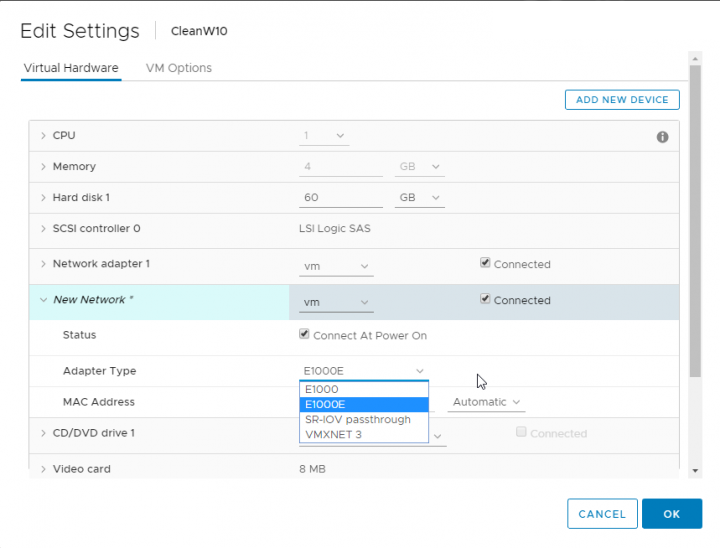
Depending on the operating system and its version you can use different network adapter types, those adapter types may vary. In this post we are discussing about different virtual network adapters
The type of network adapters that are available depend on the following factors:
The following NIC types are supported:
E1000E
Emulated version of the Intel 82574 Gigabit Ethernet NIC. E1000E is the default adapter for Windows 8 and Windows Server 2012.
E1000
Emulated version of the Intel 82545EM Gigabit Ethernet NIC, with drivers available in most newer guest operating systems, including Windows XP and later and Linux versions 2.4.19 and later.
Flexible
Identifies itself as a Vlance adapter when a virtual machine boots, but initializes itself and functions as either a Vlance or a VMXNET adapter, depending on which driver initializes it. With VMware Tools installed, the VMXNET driver changes the Vlance adapter to the higher performance VMXNET adapter.
Vlance
Emulated version of the AMD 79C970 PCnet32 LANCE NIC, an older 10 Mbps NIC with drivers available in 32-bit legacy guest operating systems. A virtual machine configured with this network adapter can use its network immediately.
VMXNET
Optimized for performance in a virtual machine and has no physical counterpart. Because operating system vendors do not provide built-in drivers for this card, you must install VMware Tools to have a driver for the VMXNET network adapter available.
VMXNET 2 (Enhanced)
Based on the VMXNET adapter but provides high-performance features commonly used on modern networks, such as jumbo frames and hardware offloads. VMXNET 2 (Enhanced) is available only for some guest operating systems on ESX/ESXi 3.5 and later.
VMXNET 3
A paravirtualized NIC designed for performance. VMXNET 3 offers all the features available in VMXNET 2 and adds several new features, such as multiqueue support (also known as Receive Side Scaling in Windows), IPv6 offloads, and MSI/MSI-X interrupt delivery. VMXNET 3 is not related to VMXNET or VMXNET 2.
PVRDMA
A paravirtualized NIC that supports remote direct memory access (RDMA) between virtual machines through the OFED verbs API. All virtual machines must have a PVRDMA device and should be connected to a distributed switch. PVRDMA supports VMware vSphere vMotion and snapshot technology. It is available in virtual machines with hardware version 13 and guest operating system Linux kernel 4.6 and later.
For information about assigning an PVRDMA network adapter to a virtual machine, see the vSphere Networking documentation.
SR-IOV passthrough
Representation of a virtual function (VF) on a physical NIC with SR-IOV support. The virtual machine and the physical adapter exchange data without using the VMkernel as an intermediary. This adapter type is suitable for virtual machines where latency might cause failure or that require more CPU resources.
SR-IOV passthrough is available in ESXi 5.5 and later for guest operating systems Red Hat Enterprise Linux 6 and later, and Windows Server 2008 R2 with SP2. An operating system release might contain a default VF driver for certain NICs, while for others you must download and install it from a location provided by the vendor of the NIC or of the host.
You can Find the Type of Adapter Available on below image

If you’re looking for a compatibility, you might want to check VMware Compatibility guide.